Entry Strategies for CHEERS Company Limited in the Indian Market
VerifiedAdded on 2019/11/19
|15
|3265
|286
Report
AI Summary
The assignment content discusses the potential for global business expansion into the Indian market, highlighting its fast-growing economy and less competitive nature compared to other countries like Japan, Mexico, Europe, and Canada. To successfully enter the Indian market, businesses must consider factors such as infrastructure, culture, product acceptability, and familiarity. CHEERS Company Limited is considering expanding into India and has several options for entry, including exporting products or adopting a joint venture with a local company.
Contribute Materials
Your contribution can guide someone’s learning journey. Share your
documents today.
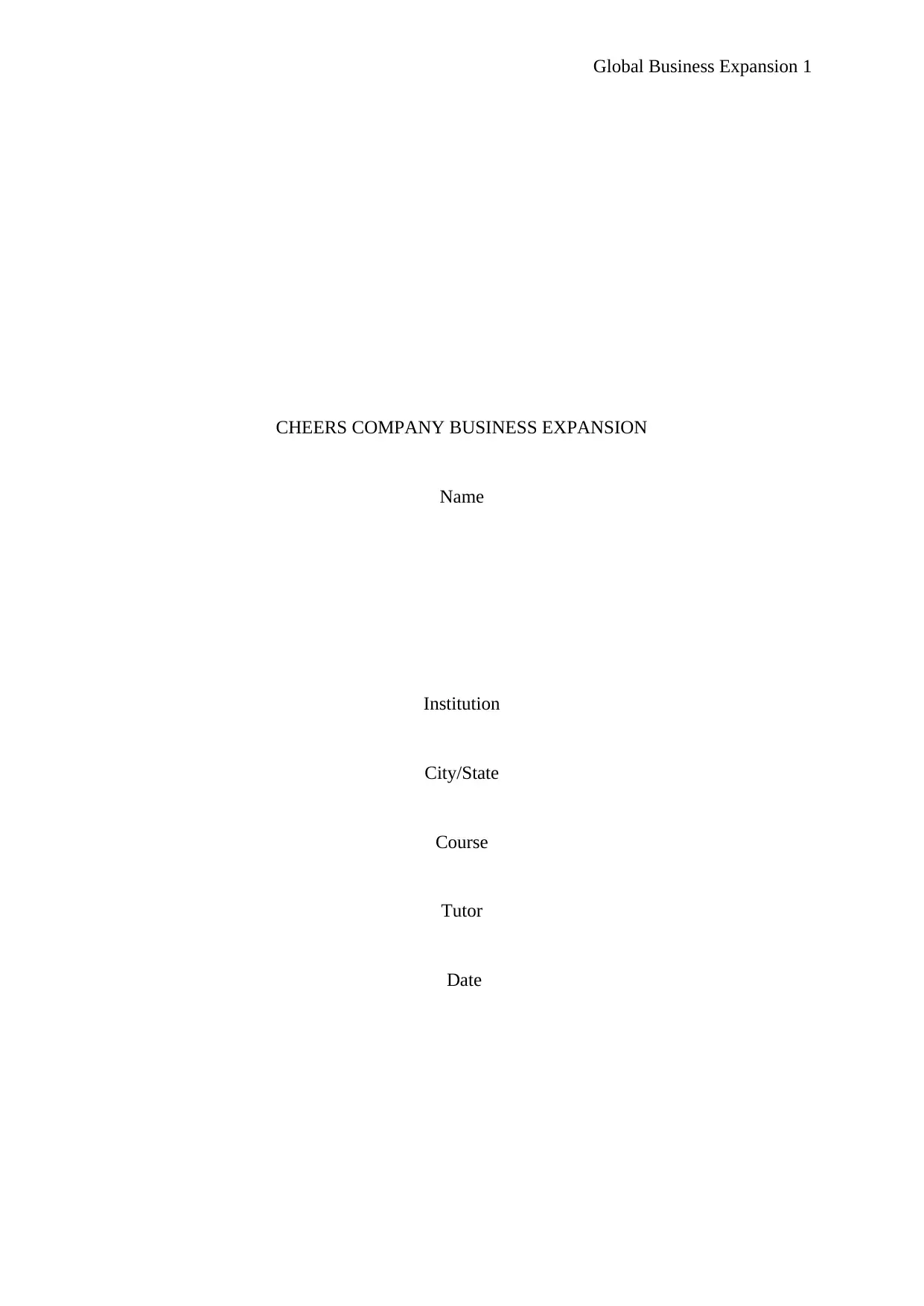
Global Business Expansion 1
CHEERS COMPANY BUSINESS EXPANSION
Name
Institution
City/State
Course
Tutor
Date
CHEERS COMPANY BUSINESS EXPANSION
Name
Institution
City/State
Course
Tutor
Date
Secure Best Marks with AI Grader
Need help grading? Try our AI Grader for instant feedback on your assignments.
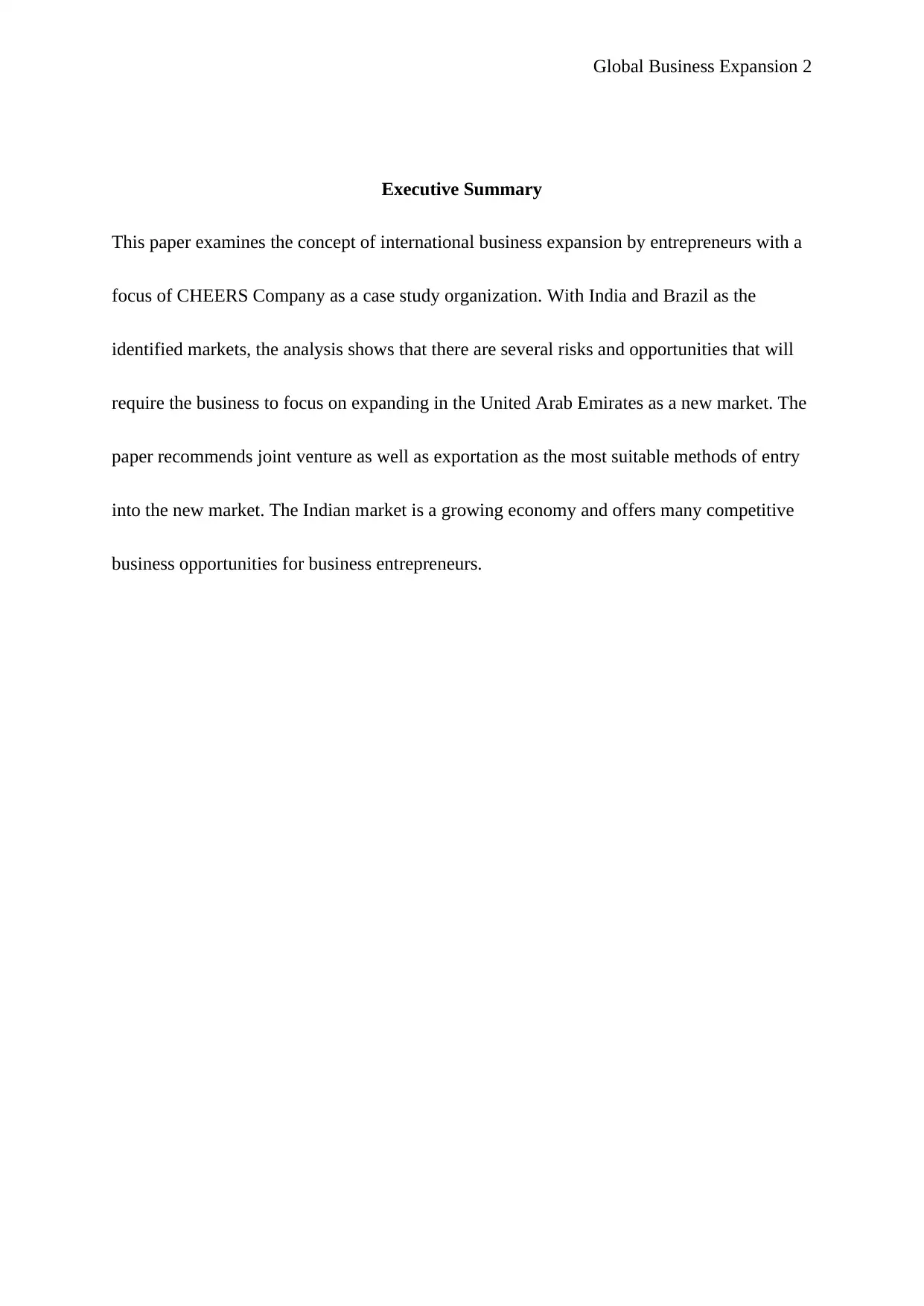
Global Business Expansion 2
Executive Summary
This paper examines the concept of international business expansion by entrepreneurs with a
focus of CHEERS Company as a case study organization. With India and Brazil as the
identified markets, the analysis shows that there are several risks and opportunities that will
require the business to focus on expanding in the United Arab Emirates as a new market. The
paper recommends joint venture as well as exportation as the most suitable methods of entry
into the new market. The Indian market is a growing economy and offers many competitive
business opportunities for business entrepreneurs.
Executive Summary
This paper examines the concept of international business expansion by entrepreneurs with a
focus of CHEERS Company as a case study organization. With India and Brazil as the
identified markets, the analysis shows that there are several risks and opportunities that will
require the business to focus on expanding in the United Arab Emirates as a new market. The
paper recommends joint venture as well as exportation as the most suitable methods of entry
into the new market. The Indian market is a growing economy and offers many competitive
business opportunities for business entrepreneurs.
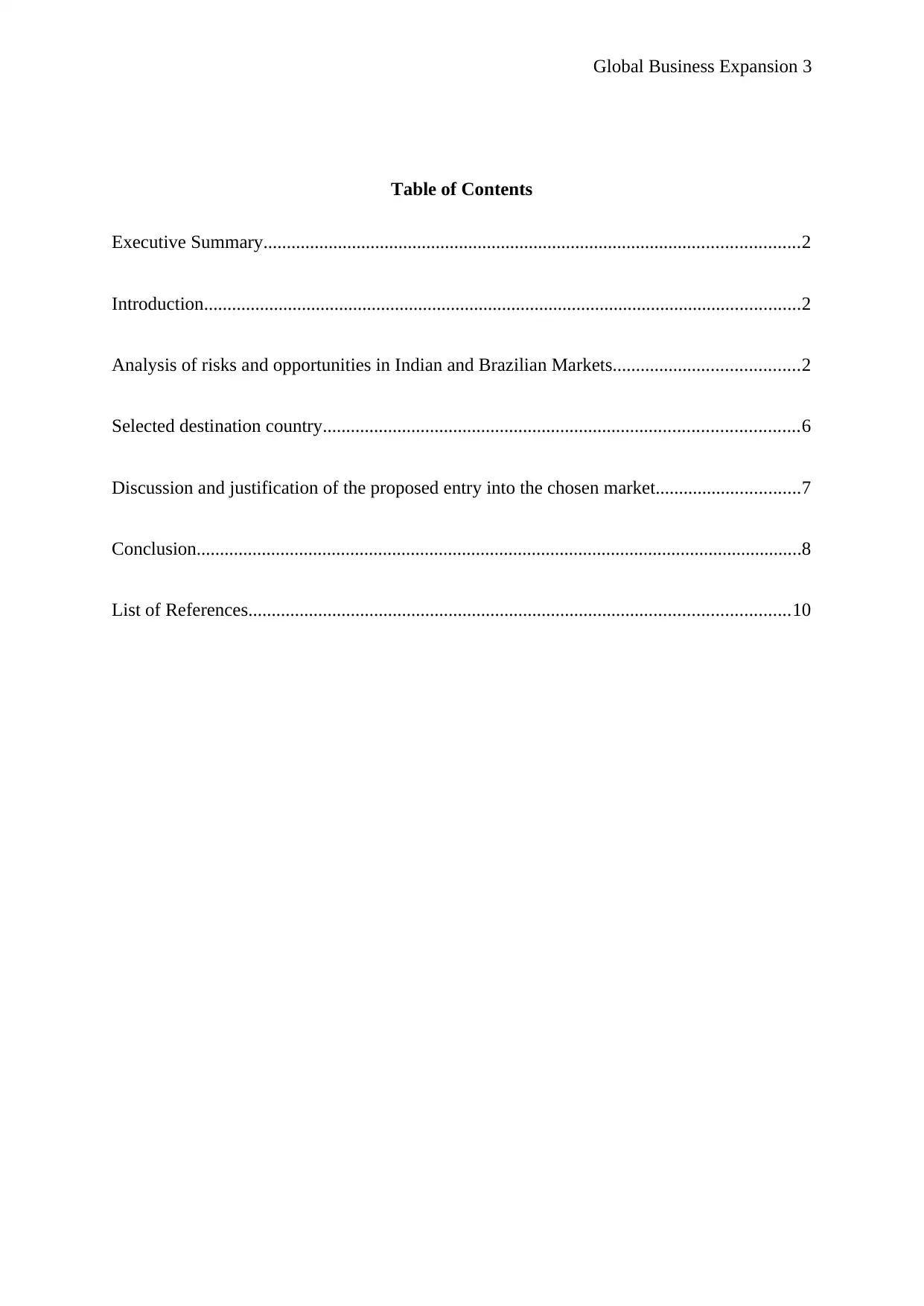
Global Business Expansion 3
Table of Contents
Executive Summary...................................................................................................................2
Introduction................................................................................................................................2
Analysis of risks and opportunities in Indian and Brazilian Markets........................................2
Selected destination country......................................................................................................6
Discussion and justification of the proposed entry into the chosen market...............................7
Conclusion..................................................................................................................................8
List of References....................................................................................................................10
Table of Contents
Executive Summary...................................................................................................................2
Introduction................................................................................................................................2
Analysis of risks and opportunities in Indian and Brazilian Markets........................................2
Selected destination country......................................................................................................6
Discussion and justification of the proposed entry into the chosen market...............................7
Conclusion..................................................................................................................................8
List of References....................................................................................................................10
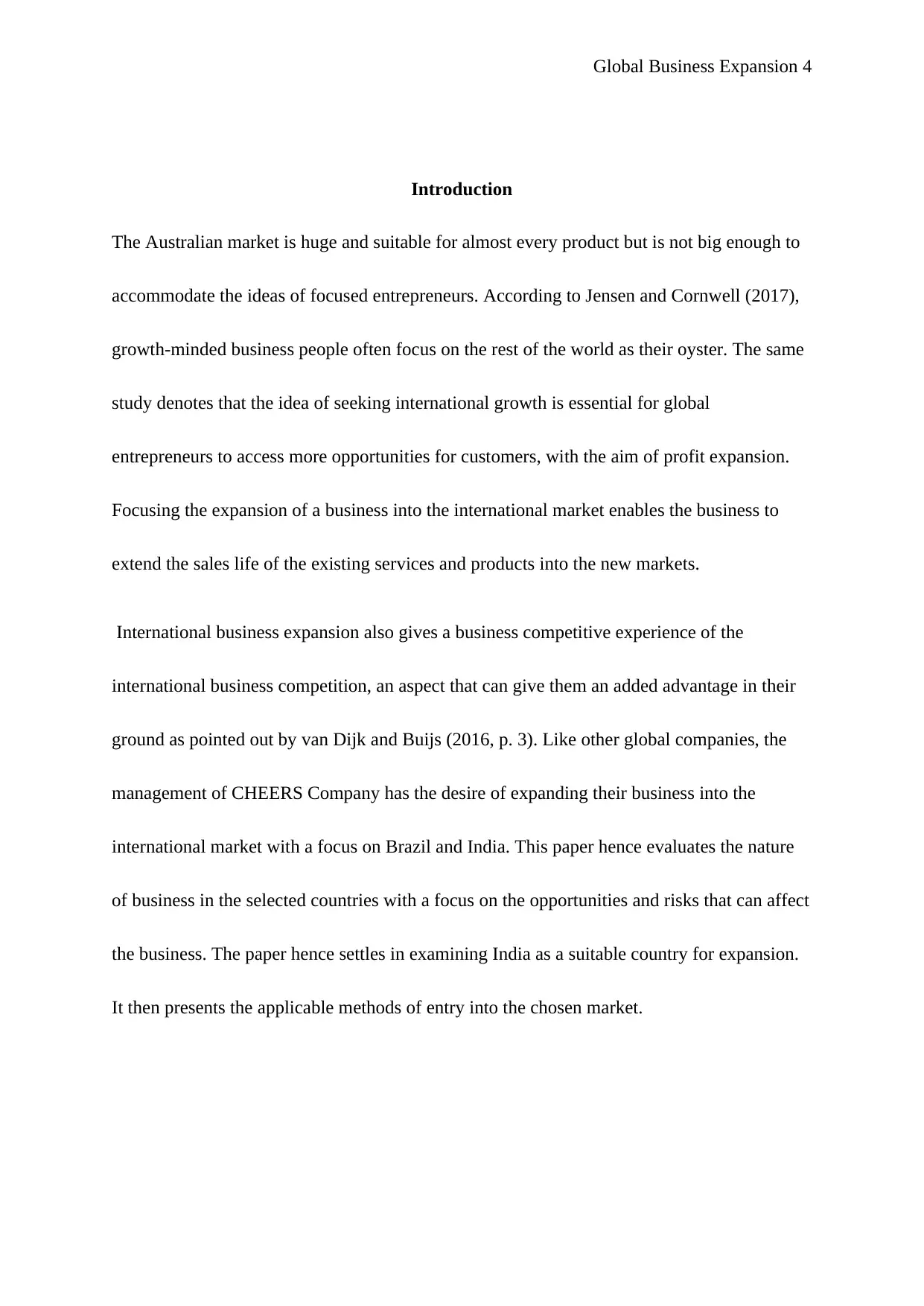
Global Business Expansion 4
Introduction
The Australian market is huge and suitable for almost every product but is not big enough to
accommodate the ideas of focused entrepreneurs. According to Jensen and Cornwell (2017),
growth-minded business people often focus on the rest of the world as their oyster. The same
study denotes that the idea of seeking international growth is essential for global
entrepreneurs to access more opportunities for customers, with the aim of profit expansion.
Focusing the expansion of a business into the international market enables the business to
extend the sales life of the existing services and products into the new markets.
International business expansion also gives a business competitive experience of the
international business competition, an aspect that can give them an added advantage in their
ground as pointed out by van Dijk and Buijs (2016, p. 3). Like other global companies, the
management of CHEERS Company has the desire of expanding their business into the
international market with a focus on Brazil and India. This paper hence evaluates the nature
of business in the selected countries with a focus on the opportunities and risks that can affect
the business. The paper hence settles in examining India as a suitable country for expansion.
It then presents the applicable methods of entry into the chosen market.
Introduction
The Australian market is huge and suitable for almost every product but is not big enough to
accommodate the ideas of focused entrepreneurs. According to Jensen and Cornwell (2017),
growth-minded business people often focus on the rest of the world as their oyster. The same
study denotes that the idea of seeking international growth is essential for global
entrepreneurs to access more opportunities for customers, with the aim of profit expansion.
Focusing the expansion of a business into the international market enables the business to
extend the sales life of the existing services and products into the new markets.
International business expansion also gives a business competitive experience of the
international business competition, an aspect that can give them an added advantage in their
ground as pointed out by van Dijk and Buijs (2016, p. 3). Like other global companies, the
management of CHEERS Company has the desire of expanding their business into the
international market with a focus on Brazil and India. This paper hence evaluates the nature
of business in the selected countries with a focus on the opportunities and risks that can affect
the business. The paper hence settles in examining India as a suitable country for expansion.
It then presents the applicable methods of entry into the chosen market.
Secure Best Marks with AI Grader
Need help grading? Try our AI Grader for instant feedback on your assignments.
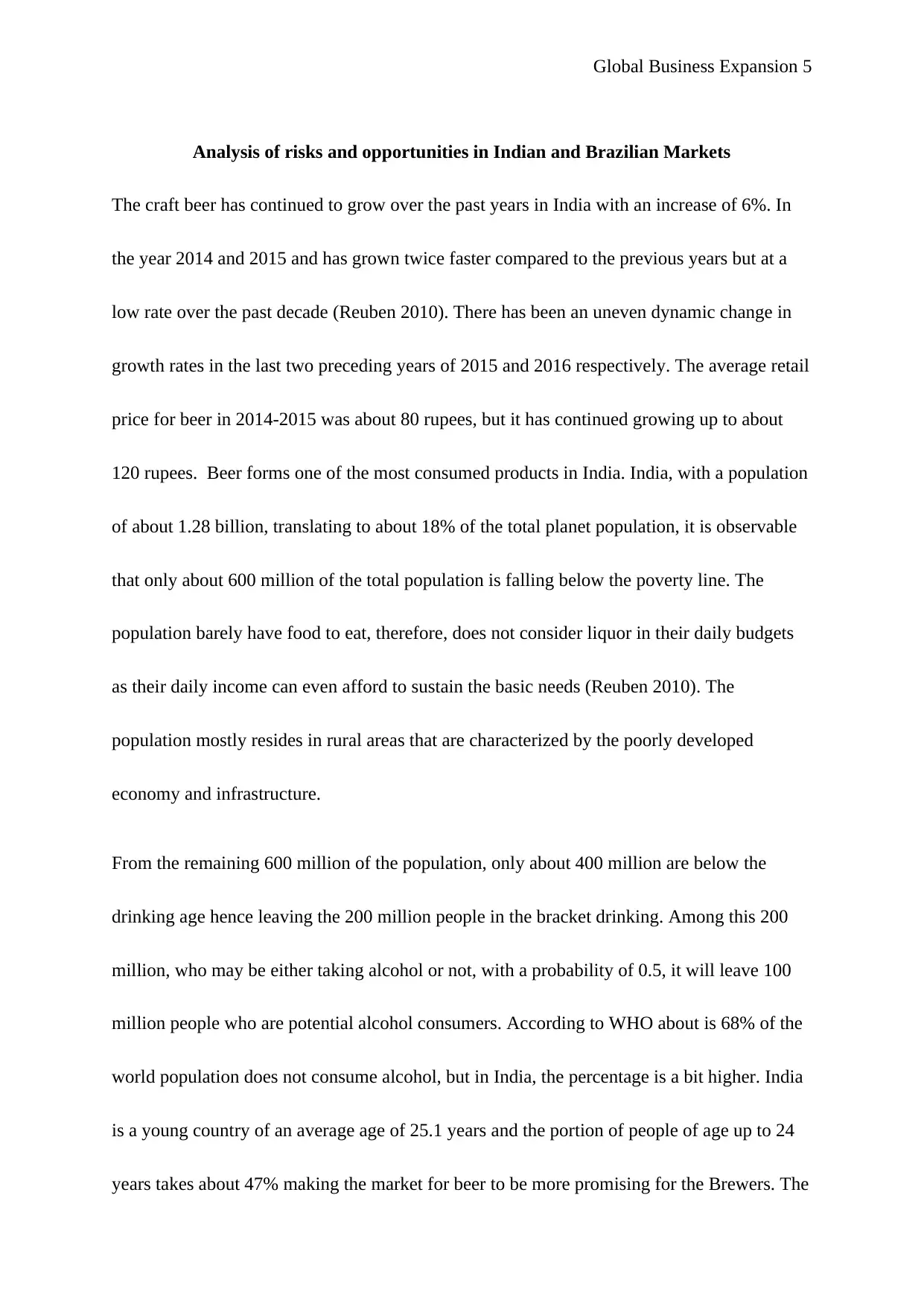
Global Business Expansion 5
Analysis of risks and opportunities in Indian and Brazilian Markets
The craft beer has continued to grow over the past years in India with an increase of 6%. In
the year 2014 and 2015 and has grown twice faster compared to the previous years but at a
low rate over the past decade (Reuben 2010). There has been an uneven dynamic change in
growth rates in the last two preceding years of 2015 and 2016 respectively. The average retail
price for beer in 2014-2015 was about 80 rupees, but it has continued growing up to about
120 rupees. Beer forms one of the most consumed products in India. India, with a population
of about 1.28 billion, translating to about 18% of the total planet population, it is observable
that only about 600 million of the total population is falling below the poverty line. The
population barely have food to eat, therefore, does not consider liquor in their daily budgets
as their daily income can even afford to sustain the basic needs (Reuben 2010). The
population mostly resides in rural areas that are characterized by the poorly developed
economy and infrastructure.
From the remaining 600 million of the population, only about 400 million are below the
drinking age hence leaving the 200 million people in the bracket drinking. Among this 200
million, who may be either taking alcohol or not, with a probability of 0.5, it will leave 100
million people who are potential alcohol consumers. According to WHO about is 68% of the
world population does not consume alcohol, but in India, the percentage is a bit higher. India
is a young country of an average age of 25.1 years and the portion of people of age up to 24
years takes about 47% making the market for beer to be more promising for the Brewers. The
Analysis of risks and opportunities in Indian and Brazilian Markets
The craft beer has continued to grow over the past years in India with an increase of 6%. In
the year 2014 and 2015 and has grown twice faster compared to the previous years but at a
low rate over the past decade (Reuben 2010). There has been an uneven dynamic change in
growth rates in the last two preceding years of 2015 and 2016 respectively. The average retail
price for beer in 2014-2015 was about 80 rupees, but it has continued growing up to about
120 rupees. Beer forms one of the most consumed products in India. India, with a population
of about 1.28 billion, translating to about 18% of the total planet population, it is observable
that only about 600 million of the total population is falling below the poverty line. The
population barely have food to eat, therefore, does not consider liquor in their daily budgets
as their daily income can even afford to sustain the basic needs (Reuben 2010). The
population mostly resides in rural areas that are characterized by the poorly developed
economy and infrastructure.
From the remaining 600 million of the population, only about 400 million are below the
drinking age hence leaving the 200 million people in the bracket drinking. Among this 200
million, who may be either taking alcohol or not, with a probability of 0.5, it will leave 100
million people who are potential alcohol consumers. According to WHO about is 68% of the
world population does not consume alcohol, but in India, the percentage is a bit higher. India
is a young country of an average age of 25.1 years and the portion of people of age up to 24
years takes about 47% making the market for beer to be more promising for the Brewers. The
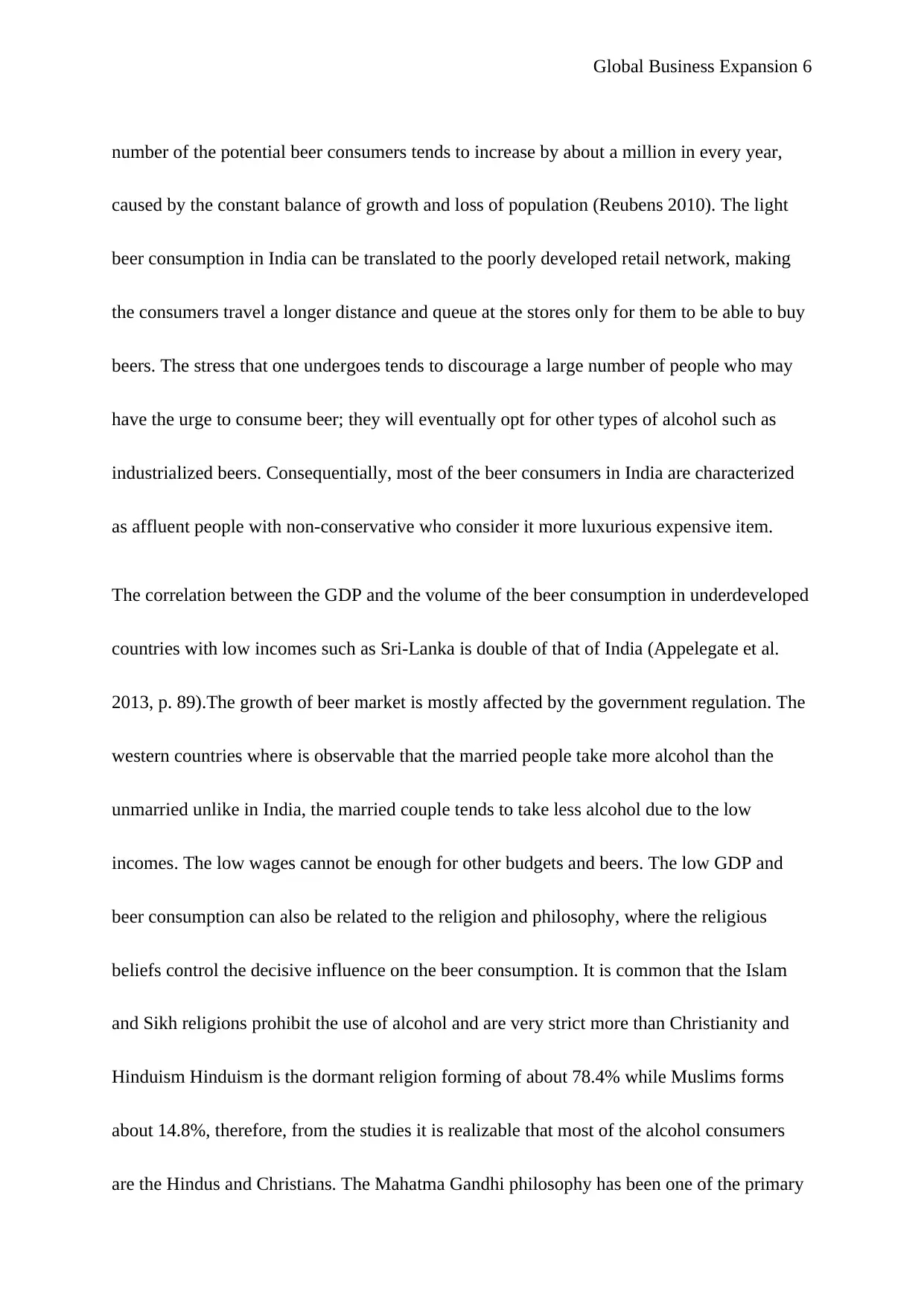
Global Business Expansion 6
number of the potential beer consumers tends to increase by about a million in every year,
caused by the constant balance of growth and loss of population (Reubens 2010). The light
beer consumption in India can be translated to the poorly developed retail network, making
the consumers travel a longer distance and queue at the stores only for them to be able to buy
beers. The stress that one undergoes tends to discourage a large number of people who may
have the urge to consume beer; they will eventually opt for other types of alcohol such as
industrialized beers. Consequentially, most of the beer consumers in India are characterized
as affluent people with non-conservative who consider it more luxurious expensive item.
The correlation between the GDP and the volume of the beer consumption in underdeveloped
countries with low incomes such as Sri-Lanka is double of that of India (Appelegate et al.
2013, p. 89).The growth of beer market is mostly affected by the government regulation. The
western countries where is observable that the married people take more alcohol than the
unmarried unlike in India, the married couple tends to take less alcohol due to the low
incomes. The low wages cannot be enough for other budgets and beers. The low GDP and
beer consumption can also be related to the religion and philosophy, where the religious
beliefs control the decisive influence on the beer consumption. It is common that the Islam
and Sikh religions prohibit the use of alcohol and are very strict more than Christianity and
Hinduism Hinduism is the dormant religion forming of about 78.4% while Muslims forms
about 14.8%, therefore, from the studies it is realizable that most of the alcohol consumers
are the Hindus and Christians. The Mahatma Gandhi philosophy has been one of the primary
number of the potential beer consumers tends to increase by about a million in every year,
caused by the constant balance of growth and loss of population (Reubens 2010). The light
beer consumption in India can be translated to the poorly developed retail network, making
the consumers travel a longer distance and queue at the stores only for them to be able to buy
beers. The stress that one undergoes tends to discourage a large number of people who may
have the urge to consume beer; they will eventually opt for other types of alcohol such as
industrialized beers. Consequentially, most of the beer consumers in India are characterized
as affluent people with non-conservative who consider it more luxurious expensive item.
The correlation between the GDP and the volume of the beer consumption in underdeveloped
countries with low incomes such as Sri-Lanka is double of that of India (Appelegate et al.
2013, p. 89).The growth of beer market is mostly affected by the government regulation. The
western countries where is observable that the married people take more alcohol than the
unmarried unlike in India, the married couple tends to take less alcohol due to the low
incomes. The low wages cannot be enough for other budgets and beers. The low GDP and
beer consumption can also be related to the religion and philosophy, where the religious
beliefs control the decisive influence on the beer consumption. It is common that the Islam
and Sikh religions prohibit the use of alcohol and are very strict more than Christianity and
Hinduism Hinduism is the dormant religion forming of about 78.4% while Muslims forms
about 14.8%, therefore, from the studies it is realizable that most of the alcohol consumers
are the Hindus and Christians. The Mahatma Gandhi philosophy has been one of the primary
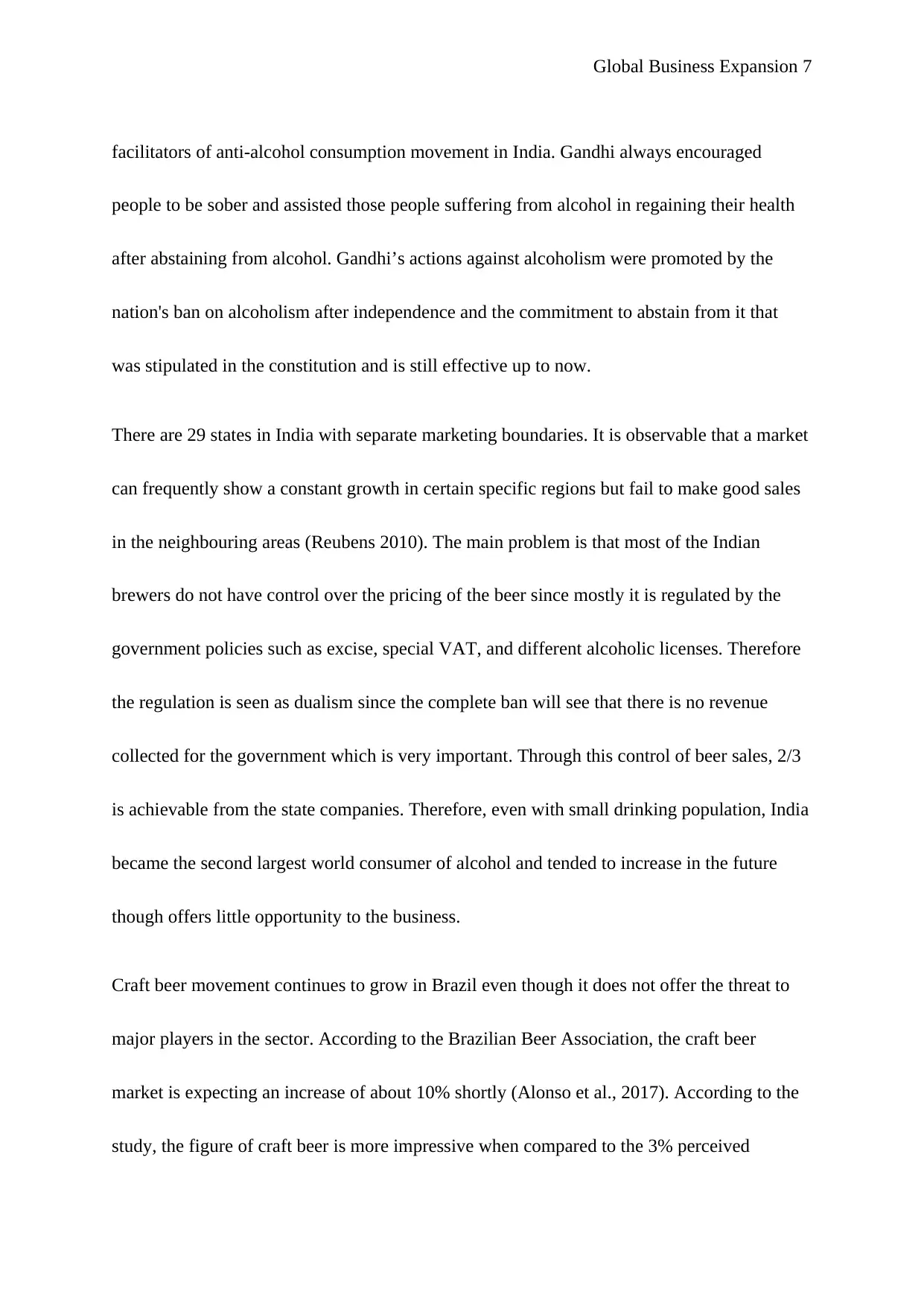
Global Business Expansion 7
facilitators of anti-alcohol consumption movement in India. Gandhi always encouraged
people to be sober and assisted those people suffering from alcohol in regaining their health
after abstaining from alcohol. Gandhi’s actions against alcoholism were promoted by the
nation's ban on alcoholism after independence and the commitment to abstain from it that
was stipulated in the constitution and is still effective up to now.
There are 29 states in India with separate marketing boundaries. It is observable that a market
can frequently show a constant growth in certain specific regions but fail to make good sales
in the neighbouring areas (Reubens 2010). The main problem is that most of the Indian
brewers do not have control over the pricing of the beer since mostly it is regulated by the
government policies such as excise, special VAT, and different alcoholic licenses. Therefore
the regulation is seen as dualism since the complete ban will see that there is no revenue
collected for the government which is very important. Through this control of beer sales, 2/3
is achievable from the state companies. Therefore, even with small drinking population, India
became the second largest world consumer of alcohol and tended to increase in the future
though offers little opportunity to the business.
Craft beer movement continues to grow in Brazil even though it does not offer the threat to
major players in the sector. According to the Brazilian Beer Association, the craft beer
market is expecting an increase of about 10% shortly (Alonso et al., 2017). According to the
study, the figure of craft beer is more impressive when compared to the 3% perceived
facilitators of anti-alcohol consumption movement in India. Gandhi always encouraged
people to be sober and assisted those people suffering from alcohol in regaining their health
after abstaining from alcohol. Gandhi’s actions against alcoholism were promoted by the
nation's ban on alcoholism after independence and the commitment to abstain from it that
was stipulated in the constitution and is still effective up to now.
There are 29 states in India with separate marketing boundaries. It is observable that a market
can frequently show a constant growth in certain specific regions but fail to make good sales
in the neighbouring areas (Reubens 2010). The main problem is that most of the Indian
brewers do not have control over the pricing of the beer since mostly it is regulated by the
government policies such as excise, special VAT, and different alcoholic licenses. Therefore
the regulation is seen as dualism since the complete ban will see that there is no revenue
collected for the government which is very important. Through this control of beer sales, 2/3
is achievable from the state companies. Therefore, even with small drinking population, India
became the second largest world consumer of alcohol and tended to increase in the future
though offers little opportunity to the business.
Craft beer movement continues to grow in Brazil even though it does not offer the threat to
major players in the sector. According to the Brazilian Beer Association, the craft beer
market is expecting an increase of about 10% shortly (Alonso et al., 2017). According to the
study, the figure of craft beer is more impressive when compared to the 3% perceived
Paraphrase This Document
Need a fresh take? Get an instant paraphrase of this document with our AI Paraphraser
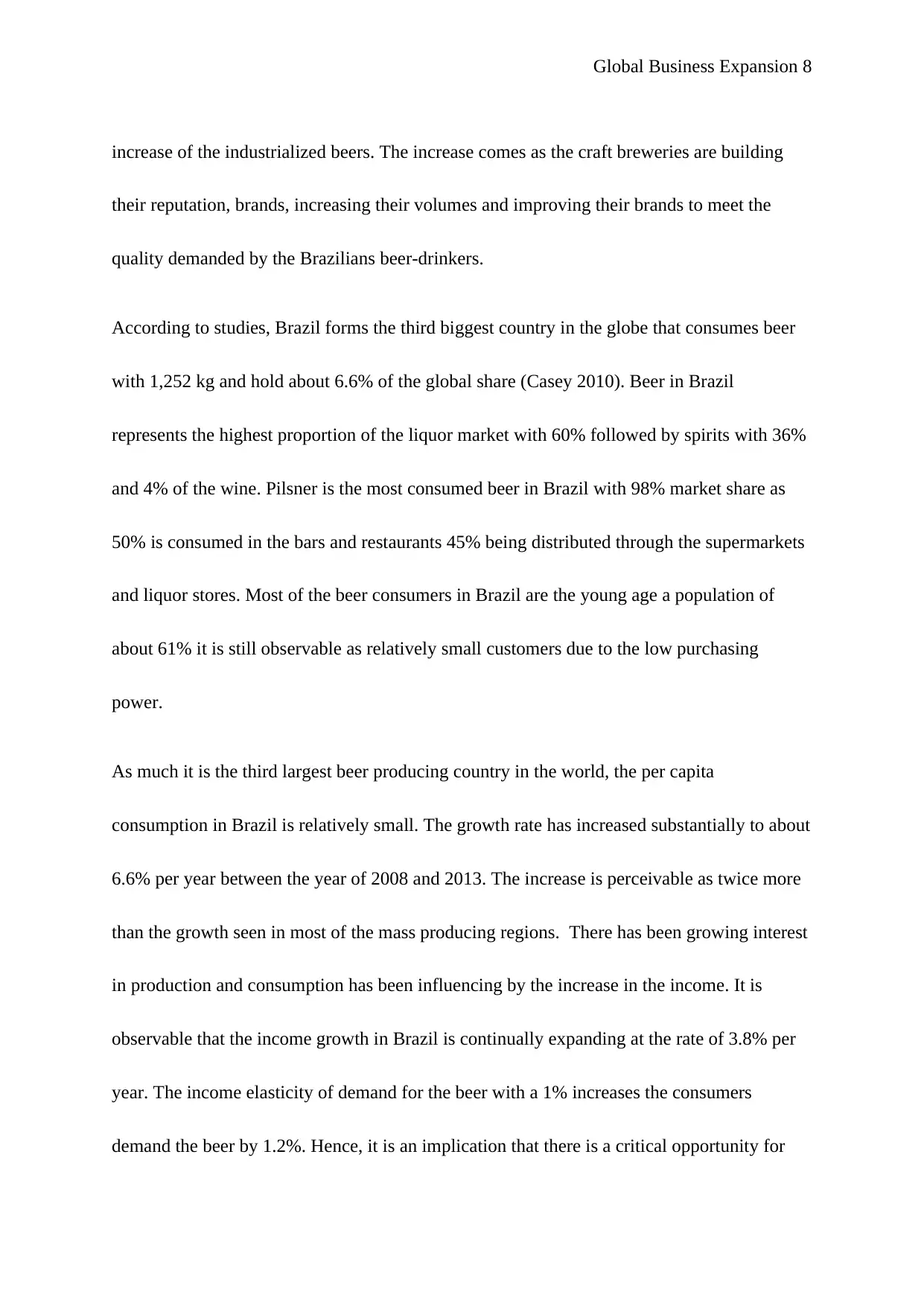
Global Business Expansion 8
increase of the industrialized beers. The increase comes as the craft breweries are building
their reputation, brands, increasing their volumes and improving their brands to meet the
quality demanded by the Brazilians beer-drinkers.
According to studies, Brazil forms the third biggest country in the globe that consumes beer
with 1,252 kg and hold about 6.6% of the global share (Casey 2010). Beer in Brazil
represents the highest proportion of the liquor market with 60% followed by spirits with 36%
and 4% of the wine. Pilsner is the most consumed beer in Brazil with 98% market share as
50% is consumed in the bars and restaurants 45% being distributed through the supermarkets
and liquor stores. Most of the beer consumers in Brazil are the young age a population of
about 61% it is still observable as relatively small customers due to the low purchasing
power.
As much it is the third largest beer producing country in the world, the per capita
consumption in Brazil is relatively small. The growth rate has increased substantially to about
6.6% per year between the year of 2008 and 2013. The increase is perceivable as twice more
than the growth seen in most of the mass producing regions. There has been growing interest
in production and consumption has been influencing by the increase in the income. It is
observable that the income growth in Brazil is continually expanding at the rate of 3.8% per
year. The income elasticity of demand for the beer with a 1% increases the consumers
demand the beer by 1.2%. Hence, it is an implication that there is a critical opportunity for
increase of the industrialized beers. The increase comes as the craft breweries are building
their reputation, brands, increasing their volumes and improving their brands to meet the
quality demanded by the Brazilians beer-drinkers.
According to studies, Brazil forms the third biggest country in the globe that consumes beer
with 1,252 kg and hold about 6.6% of the global share (Casey 2010). Beer in Brazil
represents the highest proportion of the liquor market with 60% followed by spirits with 36%
and 4% of the wine. Pilsner is the most consumed beer in Brazil with 98% market share as
50% is consumed in the bars and restaurants 45% being distributed through the supermarkets
and liquor stores. Most of the beer consumers in Brazil are the young age a population of
about 61% it is still observable as relatively small customers due to the low purchasing
power.
As much it is the third largest beer producing country in the world, the per capita
consumption in Brazil is relatively small. The growth rate has increased substantially to about
6.6% per year between the year of 2008 and 2013. The increase is perceivable as twice more
than the growth seen in most of the mass producing regions. There has been growing interest
in production and consumption has been influencing by the increase in the income. It is
observable that the income growth in Brazil is continually expanding at the rate of 3.8% per
year. The income elasticity of demand for the beer with a 1% increases the consumers
demand the beer by 1.2%. Hence, it is an implication that there is a critical opportunity for
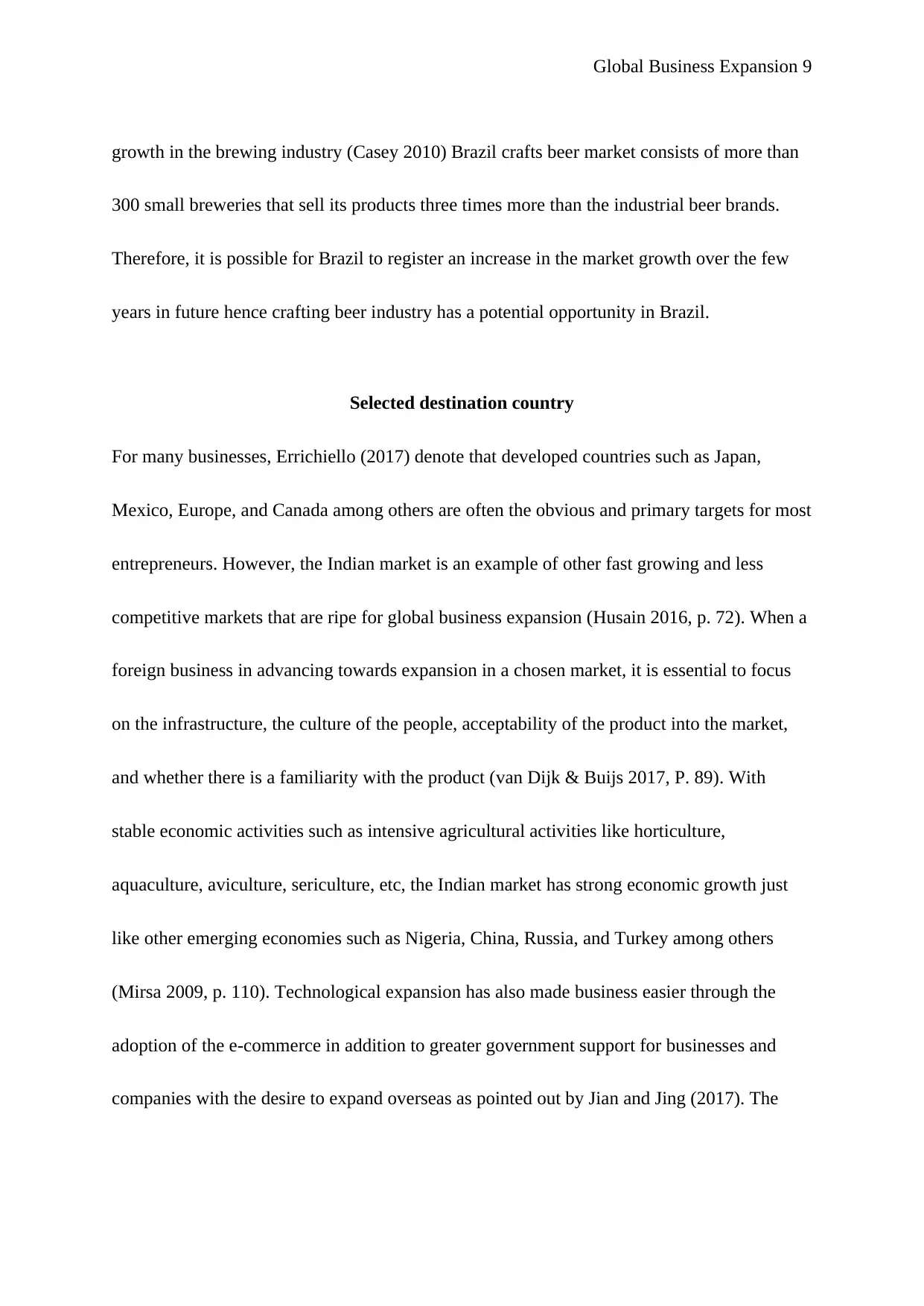
Global Business Expansion 9
growth in the brewing industry (Casey 2010) Brazil crafts beer market consists of more than
300 small breweries that sell its products three times more than the industrial beer brands.
Therefore, it is possible for Brazil to register an increase in the market growth over the few
years in future hence crafting beer industry has a potential opportunity in Brazil.
Selected destination country
For many businesses, Errichiello (2017) denote that developed countries such as Japan,
Mexico, Europe, and Canada among others are often the obvious and primary targets for most
entrepreneurs. However, the Indian market is an example of other fast growing and less
competitive markets that are ripe for global business expansion (Husain 2016, p. 72). When a
foreign business in advancing towards expansion in a chosen market, it is essential to focus
on the infrastructure, the culture of the people, acceptability of the product into the market,
and whether there is a familiarity with the product (van Dijk & Buijs 2017, P. 89). With
stable economic activities such as intensive agricultural activities like horticulture,
aquaculture, aviculture, sericulture, etc, the Indian market has strong economic growth just
like other emerging economies such as Nigeria, China, Russia, and Turkey among others
(Mirsa 2009, p. 110). Technological expansion has also made business easier through the
adoption of the e-commerce in addition to greater government support for businesses and
companies with the desire to expand overseas as pointed out by Jian and Jing (2017). The
growth in the brewing industry (Casey 2010) Brazil crafts beer market consists of more than
300 small breweries that sell its products three times more than the industrial beer brands.
Therefore, it is possible for Brazil to register an increase in the market growth over the few
years in future hence crafting beer industry has a potential opportunity in Brazil.
Selected destination country
For many businesses, Errichiello (2017) denote that developed countries such as Japan,
Mexico, Europe, and Canada among others are often the obvious and primary targets for most
entrepreneurs. However, the Indian market is an example of other fast growing and less
competitive markets that are ripe for global business expansion (Husain 2016, p. 72). When a
foreign business in advancing towards expansion in a chosen market, it is essential to focus
on the infrastructure, the culture of the people, acceptability of the product into the market,
and whether there is a familiarity with the product (van Dijk & Buijs 2017, P. 89). With
stable economic activities such as intensive agricultural activities like horticulture,
aquaculture, aviculture, sericulture, etc, the Indian market has strong economic growth just
like other emerging economies such as Nigeria, China, Russia, and Turkey among others
(Mirsa 2009, p. 110). Technological expansion has also made business easier through the
adoption of the e-commerce in addition to greater government support for businesses and
companies with the desire to expand overseas as pointed out by Jian and Jing (2017). The
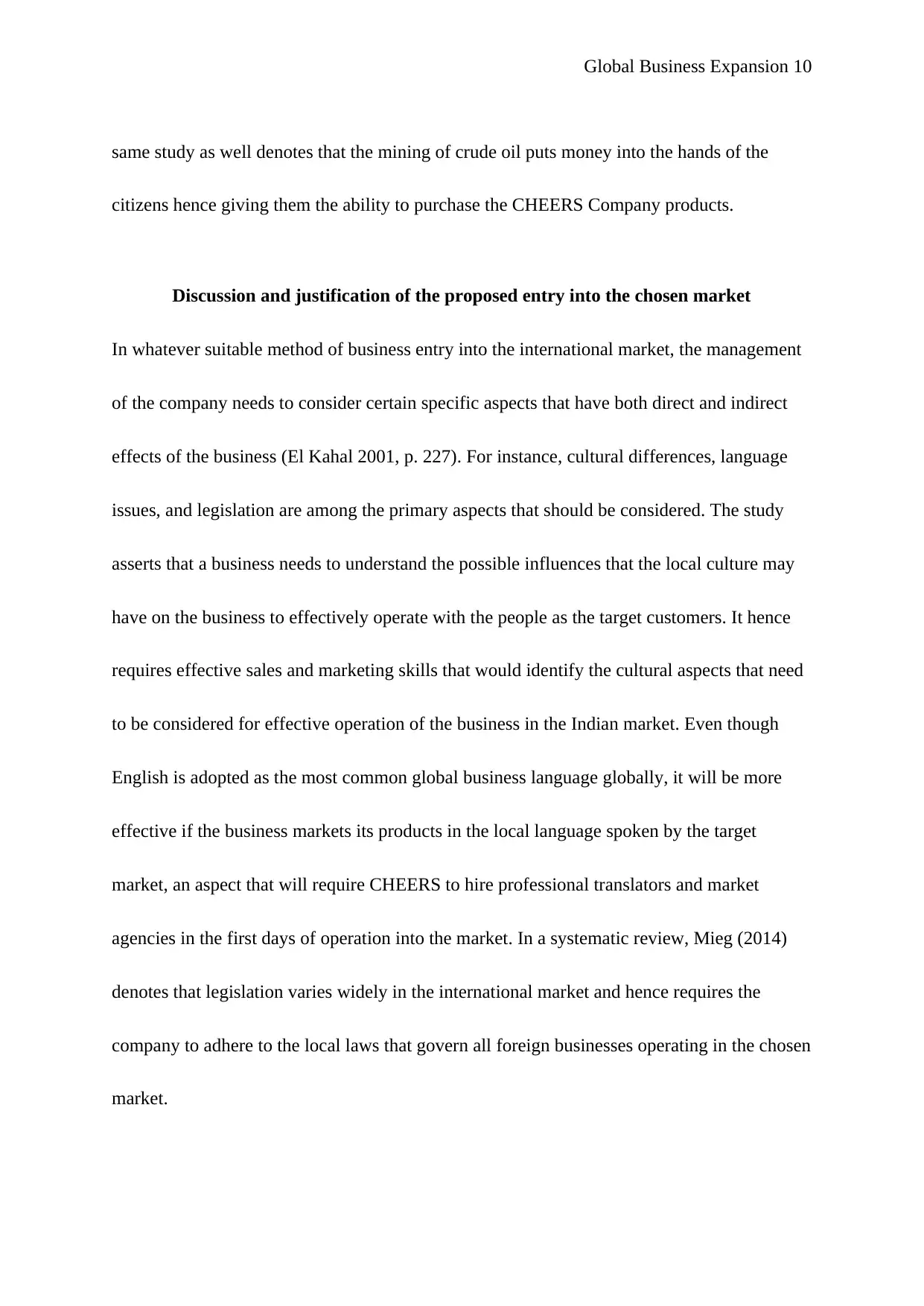
Global Business Expansion 10
same study as well denotes that the mining of crude oil puts money into the hands of the
citizens hence giving them the ability to purchase the CHEERS Company products.
Discussion and justification of the proposed entry into the chosen market
In whatever suitable method of business entry into the international market, the management
of the company needs to consider certain specific aspects that have both direct and indirect
effects of the business (El Kahal 2001, p. 227). For instance, cultural differences, language
issues, and legislation are among the primary aspects that should be considered. The study
asserts that a business needs to understand the possible influences that the local culture may
have on the business to effectively operate with the people as the target customers. It hence
requires effective sales and marketing skills that would identify the cultural aspects that need
to be considered for effective operation of the business in the Indian market. Even though
English is adopted as the most common global business language globally, it will be more
effective if the business markets its products in the local language spoken by the target
market, an aspect that will require CHEERS to hire professional translators and market
agencies in the first days of operation into the market. In a systematic review, Mieg (2014)
denotes that legislation varies widely in the international market and hence requires the
company to adhere to the local laws that govern all foreign businesses operating in the chosen
market.
same study as well denotes that the mining of crude oil puts money into the hands of the
citizens hence giving them the ability to purchase the CHEERS Company products.
Discussion and justification of the proposed entry into the chosen market
In whatever suitable method of business entry into the international market, the management
of the company needs to consider certain specific aspects that have both direct and indirect
effects of the business (El Kahal 2001, p. 227). For instance, cultural differences, language
issues, and legislation are among the primary aspects that should be considered. The study
asserts that a business needs to understand the possible influences that the local culture may
have on the business to effectively operate with the people as the target customers. It hence
requires effective sales and marketing skills that would identify the cultural aspects that need
to be considered for effective operation of the business in the Indian market. Even though
English is adopted as the most common global business language globally, it will be more
effective if the business markets its products in the local language spoken by the target
market, an aspect that will require CHEERS to hire professional translators and market
agencies in the first days of operation into the market. In a systematic review, Mieg (2014)
denotes that legislation varies widely in the international market and hence requires the
company to adhere to the local laws that govern all foreign businesses operating in the chosen
market.
Secure Best Marks with AI Grader
Need help grading? Try our AI Grader for instant feedback on your assignments.
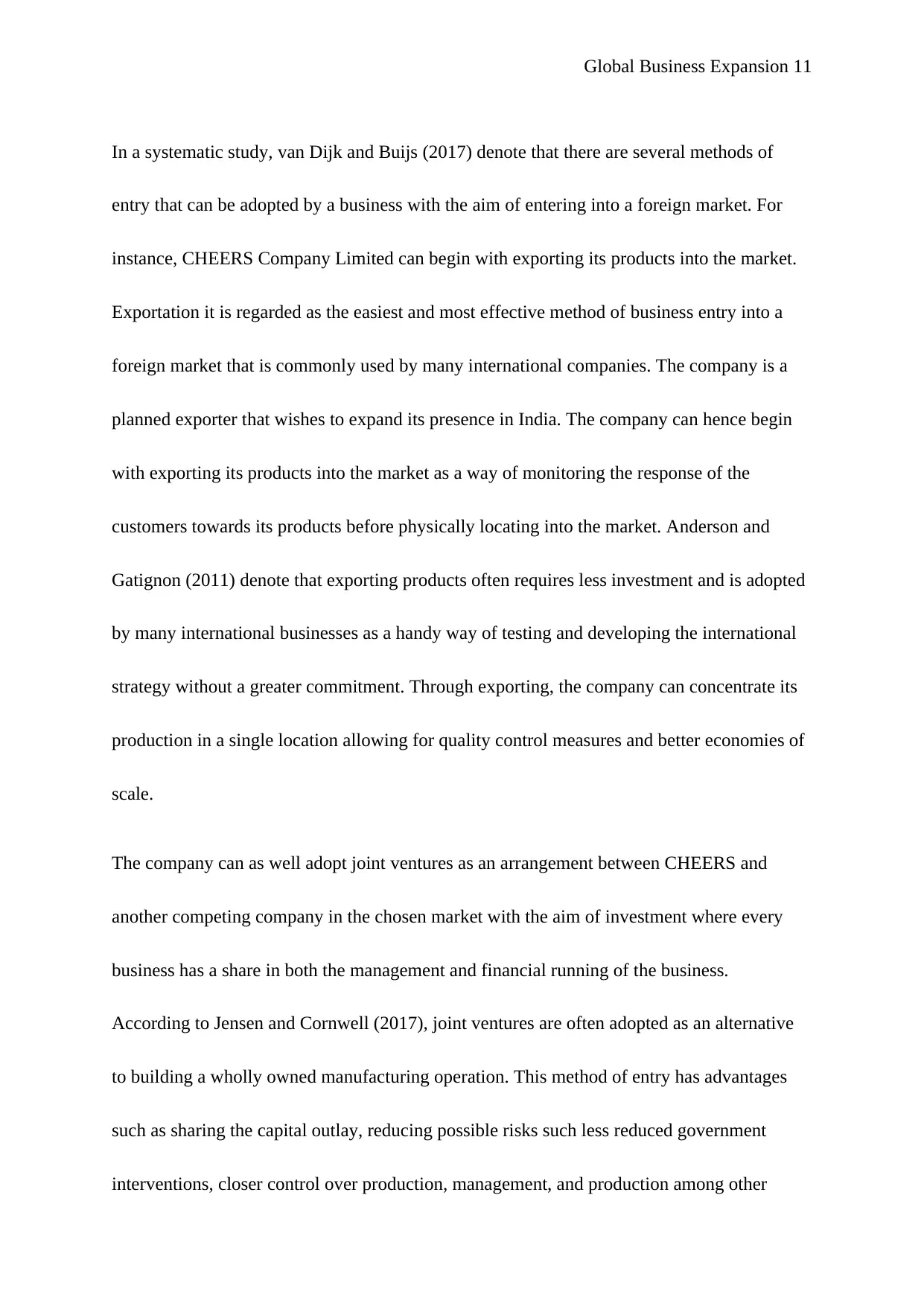
Global Business Expansion 11
In a systematic study, van Dijk and Buijs (2017) denote that there are several methods of
entry that can be adopted by a business with the aim of entering into a foreign market. For
instance, CHEERS Company Limited can begin with exporting its products into the market.
Exportation it is regarded as the easiest and most effective method of business entry into a
foreign market that is commonly used by many international companies. The company is a
planned exporter that wishes to expand its presence in India. The company can hence begin
with exporting its products into the market as a way of monitoring the response of the
customers towards its products before physically locating into the market. Anderson and
Gatignon (2011) denote that exporting products often requires less investment and is adopted
by many international businesses as a handy way of testing and developing the international
strategy without a greater commitment. Through exporting, the company can concentrate its
production in a single location allowing for quality control measures and better economies of
scale.
The company can as well adopt joint ventures as an arrangement between CHEERS and
another competing company in the chosen market with the aim of investment where every
business has a share in both the management and financial running of the business.
According to Jensen and Cornwell (2017), joint ventures are often adopted as an alternative
to building a wholly owned manufacturing operation. This method of entry has advantages
such as sharing the capital outlay, reducing possible risks such less reduced government
interventions, closer control over production, management, and production among other
In a systematic study, van Dijk and Buijs (2017) denote that there are several methods of
entry that can be adopted by a business with the aim of entering into a foreign market. For
instance, CHEERS Company Limited can begin with exporting its products into the market.
Exportation it is regarded as the easiest and most effective method of business entry into a
foreign market that is commonly used by many international companies. The company is a
planned exporter that wishes to expand its presence in India. The company can hence begin
with exporting its products into the market as a way of monitoring the response of the
customers towards its products before physically locating into the market. Anderson and
Gatignon (2011) denote that exporting products often requires less investment and is adopted
by many international businesses as a handy way of testing and developing the international
strategy without a greater commitment. Through exporting, the company can concentrate its
production in a single location allowing for quality control measures and better economies of
scale.
The company can as well adopt joint ventures as an arrangement between CHEERS and
another competing company in the chosen market with the aim of investment where every
business has a share in both the management and financial running of the business.
According to Jensen and Cornwell (2017), joint ventures are often adopted as an alternative
to building a wholly owned manufacturing operation. This method of entry has advantages
such as sharing the capital outlay, reducing possible risks such less reduced government
interventions, closer control over production, management, and production among other
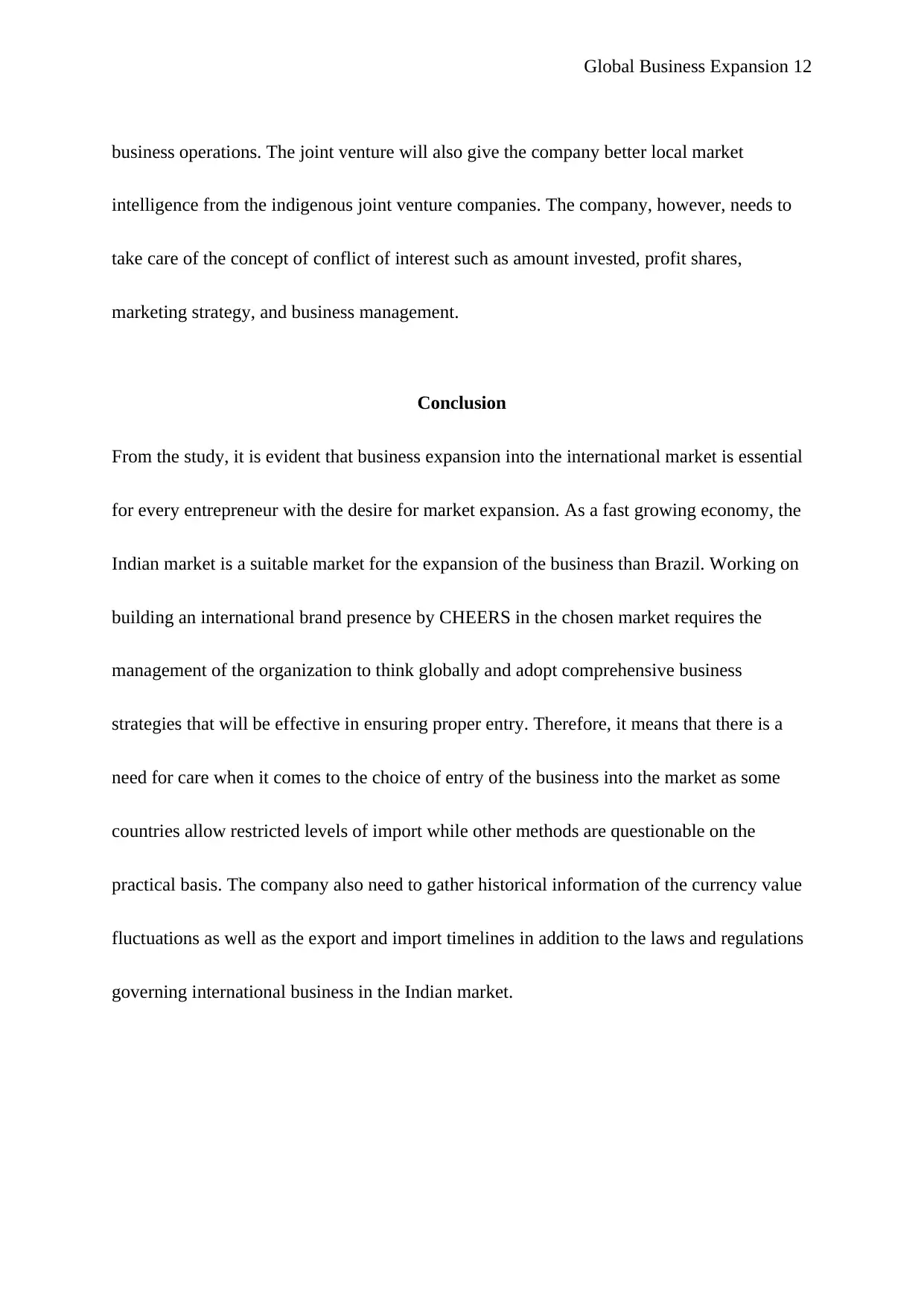
Global Business Expansion 12
business operations. The joint venture will also give the company better local market
intelligence from the indigenous joint venture companies. The company, however, needs to
take care of the concept of conflict of interest such as amount invested, profit shares,
marketing strategy, and business management.
Conclusion
From the study, it is evident that business expansion into the international market is essential
for every entrepreneur with the desire for market expansion. As a fast growing economy, the
Indian market is a suitable market for the expansion of the business than Brazil. Working on
building an international brand presence by CHEERS in the chosen market requires the
management of the organization to think globally and adopt comprehensive business
strategies that will be effective in ensuring proper entry. Therefore, it means that there is a
need for care when it comes to the choice of entry of the business into the market as some
countries allow restricted levels of import while other methods are questionable on the
practical basis. The company also need to gather historical information of the currency value
fluctuations as well as the export and import timelines in addition to the laws and regulations
governing international business in the Indian market.
business operations. The joint venture will also give the company better local market
intelligence from the indigenous joint venture companies. The company, however, needs to
take care of the concept of conflict of interest such as amount invested, profit shares,
marketing strategy, and business management.
Conclusion
From the study, it is evident that business expansion into the international market is essential
for every entrepreneur with the desire for market expansion. As a fast growing economy, the
Indian market is a suitable market for the expansion of the business than Brazil. Working on
building an international brand presence by CHEERS in the chosen market requires the
management of the organization to think globally and adopt comprehensive business
strategies that will be effective in ensuring proper entry. Therefore, it means that there is a
need for care when it comes to the choice of entry of the business into the market as some
countries allow restricted levels of import while other methods are questionable on the
practical basis. The company also need to gather historical information of the currency value
fluctuations as well as the export and import timelines in addition to the laws and regulations
governing international business in the Indian market.
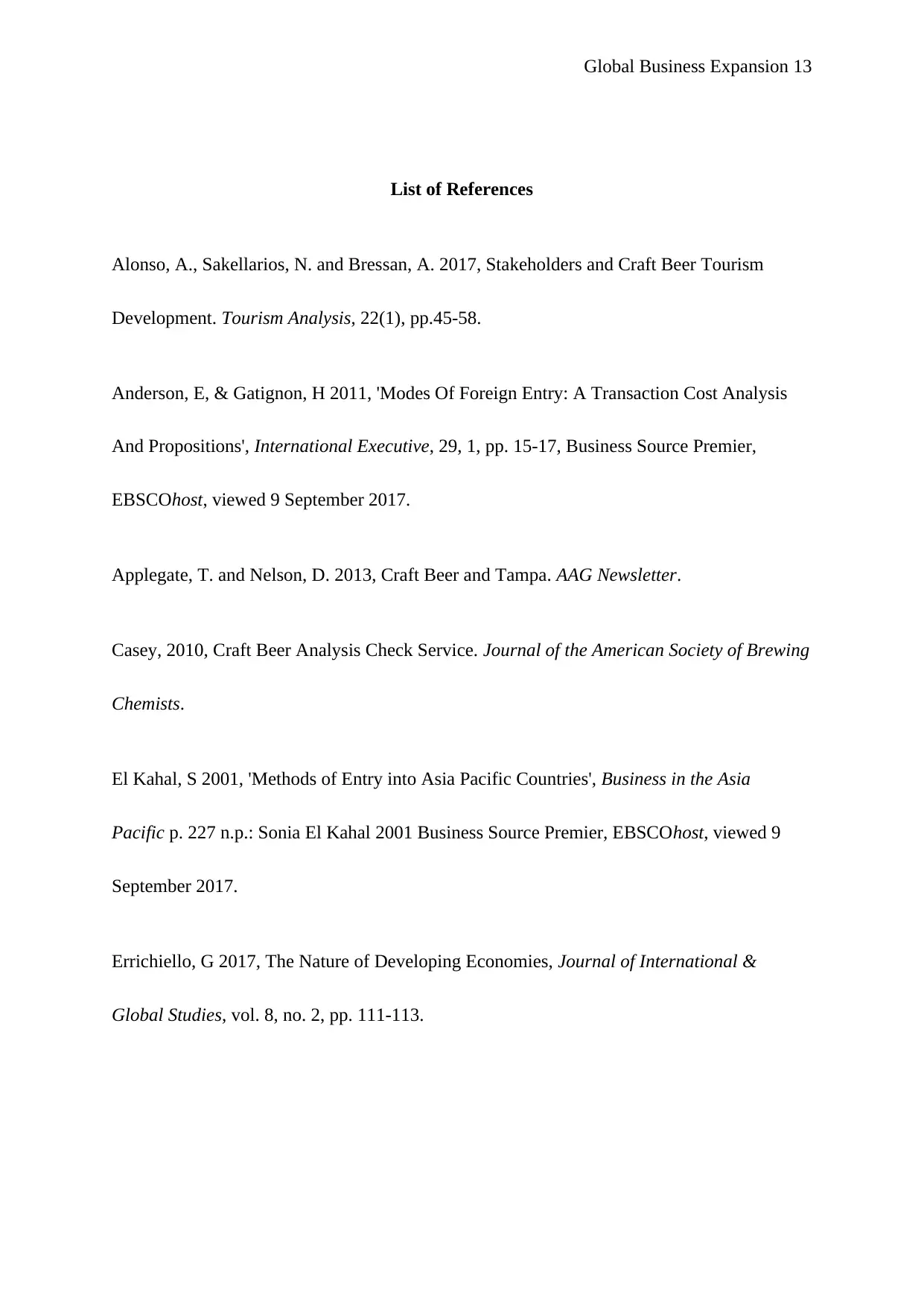
Global Business Expansion 13
List of References
Alonso, A., Sakellarios, N. and Bressan, A. 2017, Stakeholders and Craft Beer Tourism
Development. Tourism Analysis, 22(1), pp.45-58.
Anderson, E, & Gatignon, H 2011, 'Modes Of Foreign Entry: A Transaction Cost Analysis
And Propositions', International Executive, 29, 1, pp. 15-17, Business Source Premier,
EBSCOhost, viewed 9 September 2017.
Applegate, T. and Nelson, D. 2013, Craft Beer and Tampa. AAG Newsletter.
Casey, 2010, Craft Beer Analysis Check Service. Journal of the American Society of Brewing
Chemists.
El Kahal, S 2001, 'Methods of Entry into Asia Pacific Countries', Business in the Asia
Pacific p. 227 n.p.: Sonia El Kahal 2001 Business Source Premier, EBSCOhost, viewed 9
September 2017.
Errichiello, G 2017, The Nature of Developing Economies, Journal of International &
Global Studies, vol. 8, no. 2, pp. 111-113.
List of References
Alonso, A., Sakellarios, N. and Bressan, A. 2017, Stakeholders and Craft Beer Tourism
Development. Tourism Analysis, 22(1), pp.45-58.
Anderson, E, & Gatignon, H 2011, 'Modes Of Foreign Entry: A Transaction Cost Analysis
And Propositions', International Executive, 29, 1, pp. 15-17, Business Source Premier,
EBSCOhost, viewed 9 September 2017.
Applegate, T. and Nelson, D. 2013, Craft Beer and Tampa. AAG Newsletter.
Casey, 2010, Craft Beer Analysis Check Service. Journal of the American Society of Brewing
Chemists.
El Kahal, S 2001, 'Methods of Entry into Asia Pacific Countries', Business in the Asia
Pacific p. 227 n.p.: Sonia El Kahal 2001 Business Source Premier, EBSCOhost, viewed 9
September 2017.
Errichiello, G 2017, The Nature of Developing Economies, Journal of International &
Global Studies, vol. 8, no. 2, pp. 111-113.
Paraphrase This Document
Need a fresh take? Get an instant paraphrase of this document with our AI Paraphraser
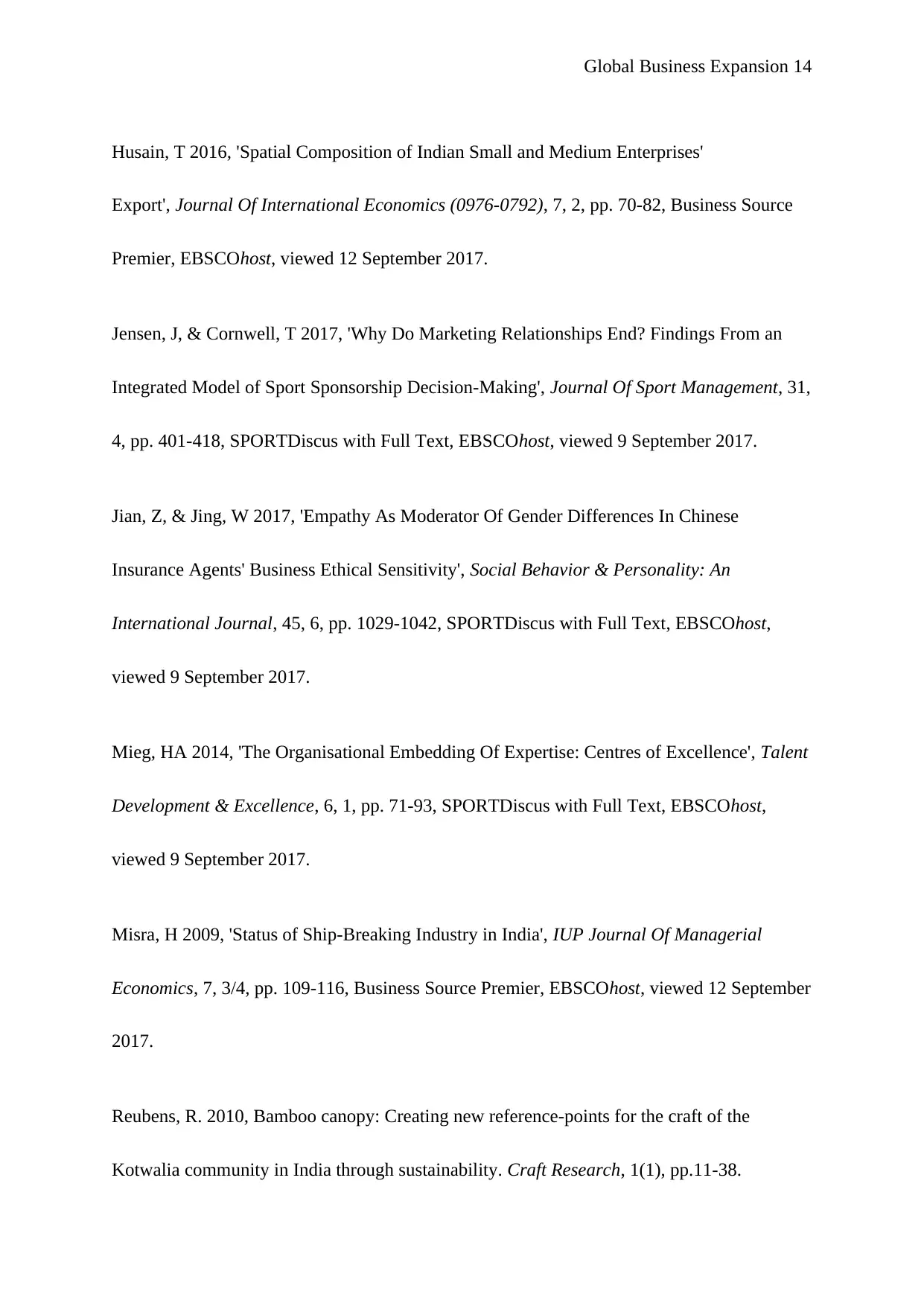
Global Business Expansion 14
Husain, T 2016, 'Spatial Composition of Indian Small and Medium Enterprises'
Export', Journal Of International Economics (0976-0792), 7, 2, pp. 70-82, Business Source
Premier, EBSCOhost, viewed 12 September 2017.
Jensen, J, & Cornwell, T 2017, 'Why Do Marketing Relationships End? Findings From an
Integrated Model of Sport Sponsorship Decision-Making', Journal Of Sport Management, 31,
4, pp. 401-418, SPORTDiscus with Full Text, EBSCOhost, viewed 9 September 2017.
Jian, Z, & Jing, W 2017, 'Empathy As Moderator Of Gender Differences In Chinese
Insurance Agents' Business Ethical Sensitivity', Social Behavior & Personality: An
International Journal, 45, 6, pp. 1029-1042, SPORTDiscus with Full Text, EBSCOhost,
viewed 9 September 2017.
Mieg, HA 2014, 'The Organisational Embedding Of Expertise: Centres of Excellence', Talent
Development & Excellence, 6, 1, pp. 71-93, SPORTDiscus with Full Text, EBSCOhost,
viewed 9 September 2017.
Misra, H 2009, 'Status of Ship-Breaking Industry in India', IUP Journal Of Managerial
Economics, 7, 3/4, pp. 109-116, Business Source Premier, EBSCOhost, viewed 12 September
2017.
Reubens, R. 2010, Bamboo canopy: Creating new reference-points for the craft of the
Kotwalia community in India through sustainability. Craft Research, 1(1), pp.11-38.
Husain, T 2016, 'Spatial Composition of Indian Small and Medium Enterprises'
Export', Journal Of International Economics (0976-0792), 7, 2, pp. 70-82, Business Source
Premier, EBSCOhost, viewed 12 September 2017.
Jensen, J, & Cornwell, T 2017, 'Why Do Marketing Relationships End? Findings From an
Integrated Model of Sport Sponsorship Decision-Making', Journal Of Sport Management, 31,
4, pp. 401-418, SPORTDiscus with Full Text, EBSCOhost, viewed 9 September 2017.
Jian, Z, & Jing, W 2017, 'Empathy As Moderator Of Gender Differences In Chinese
Insurance Agents' Business Ethical Sensitivity', Social Behavior & Personality: An
International Journal, 45, 6, pp. 1029-1042, SPORTDiscus with Full Text, EBSCOhost,
viewed 9 September 2017.
Mieg, HA 2014, 'The Organisational Embedding Of Expertise: Centres of Excellence', Talent
Development & Excellence, 6, 1, pp. 71-93, SPORTDiscus with Full Text, EBSCOhost,
viewed 9 September 2017.
Misra, H 2009, 'Status of Ship-Breaking Industry in India', IUP Journal Of Managerial
Economics, 7, 3/4, pp. 109-116, Business Source Premier, EBSCOhost, viewed 12 September
2017.
Reubens, R. 2010, Bamboo canopy: Creating new reference-points for the craft of the
Kotwalia community in India through sustainability. Craft Research, 1(1), pp.11-38.
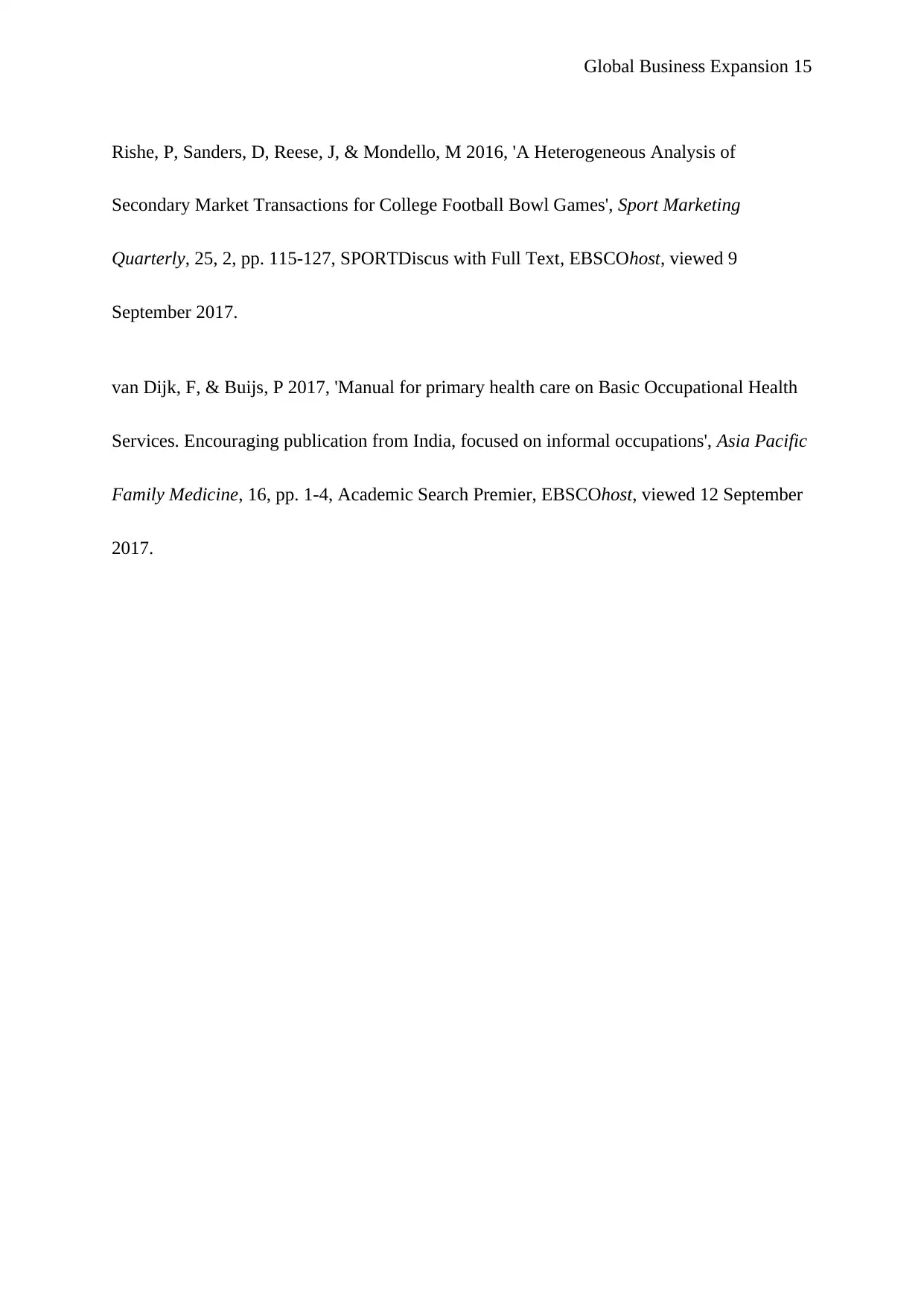
Global Business Expansion 15
Rishe, P, Sanders, D, Reese, J, & Mondello, M 2016, 'A Heterogeneous Analysis of
Secondary Market Transactions for College Football Bowl Games', Sport Marketing
Quarterly, 25, 2, pp. 115-127, SPORTDiscus with Full Text, EBSCOhost, viewed 9
September 2017.
van Dijk, F, & Buijs, P 2017, 'Manual for primary health care on Basic Occupational Health
Services. Encouraging publication from India, focused on informal occupations', Asia Pacific
Family Medicine, 16, pp. 1-4, Academic Search Premier, EBSCOhost, viewed 12 September
2017.
Rishe, P, Sanders, D, Reese, J, & Mondello, M 2016, 'A Heterogeneous Analysis of
Secondary Market Transactions for College Football Bowl Games', Sport Marketing
Quarterly, 25, 2, pp. 115-127, SPORTDiscus with Full Text, EBSCOhost, viewed 9
September 2017.
van Dijk, F, & Buijs, P 2017, 'Manual for primary health care on Basic Occupational Health
Services. Encouraging publication from India, focused on informal occupations', Asia Pacific
Family Medicine, 16, pp. 1-4, Academic Search Premier, EBSCOhost, viewed 12 September
2017.
1 out of 15
Related Documents
Your All-in-One AI-Powered Toolkit for Academic Success.
+13062052269
info@desklib.com
Available 24*7 on WhatsApp / Email
![[object Object]](/_next/static/media/star-bottom.7253800d.svg)
Unlock your academic potential
© 2024 | Zucol Services PVT LTD | All rights reserved.





